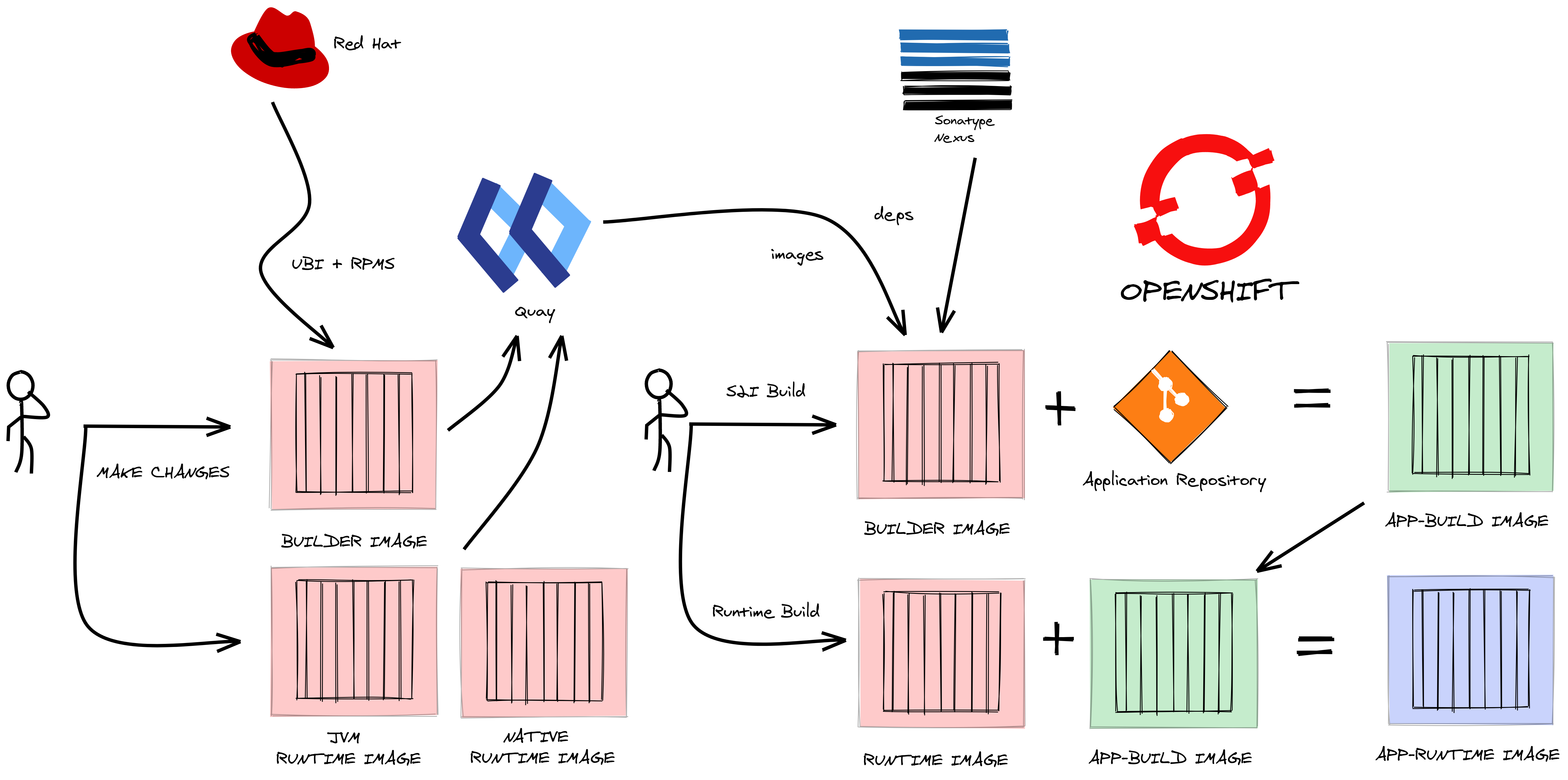ubi-mvn-builder
ubi-mvn-builder
Build JVM and Native Quarkus based application images from UBI using multi-stage docker files and latest Java toolchain.

👷👷👷 Build Toolchain:
- Quarkus (native and fast-jar)
- OpenJDK 21, maven 3.9, Mandrel 22
- UBI 9 Minimal
⚡⚡⚡ Runtime:
- UBI 9 Minimal
- Your Application
🐒🐒🐒 Why do this ?
- Latest Java toolchain
- A Secure Supply Chain
- Smaller image sizes, less attack surface:
- Builder image size = 609 MiB
- JVM runtime image size = 126 MiB
- JVM application image size = 138 MiB
- Native runtime image size = 39 MiB
- Native application image size = 67 MiB
-
Create the base s2i core build image and push to remote repo for reuse across clusters.
podman build --squash -t quay.io/eformat/ubi-mvn-builder:latest -f builder/Dockerfile podman push quay.io/eformat/ubi-mvn-builder:latest -
Create the runtimes and push to remote repo for reuse across clusters.
JVM fast-jarpodman build --squash -t quay.io/eformat/ubi-mvn-runtime-jvm:latest -f runtime/Dockerfile.jvm podman push quay.io/eformat/ubi-mvn-runtime-jvm:latestNative binarypodman build --squash -t quay.io/eformat/ubi-mvn-runtime-native:latest -f runtime/Dockerfile.native podman push quay.io/eformat/ubi-mvn-runtime-native:latest -
Login to OpenShift, create a project then create the s2i build for your applications.
oc new-project demoJVM fast-jaroc new-build --name=jvm-build \ quay.io/eformat/ubi-mvn-builder:latest~https://github.com/eformat/code-with-quarkus \ -e MAVEN_BUILD_OPTS="-Dquarkus.package.type=fast-jar -DskipTests" \ -e MAVEN_CLEAR_REPO="true"Native binaryoc new-build --name=native-build \ quay.io/eformat/ubi-mvn-builder:latest~https://github.com/eformat/code-with-quarkus \ -e MAVEN_CLEAR_REPO="true" -
Build runtime Applications.
JVM fast-jaroc new-build --name=jvm \ --build-arg BUILD_IMAGE=image-registry.openshift-image-registry.svc:5000/$(oc project -q)/jvm-build:latest \ --strategy docker --dockerfile - < ./application/Dockerfile.jvmNative binaryoc new-build --name=native \ --build-arg BUILD_IMAGE=image-registry.openshift-image-registry.svc:5000/$(oc project -q)/native-build:latest \ --strategy docker --dockerfile - < ./application/Dockerfile.native -
Deploy Applications.
JVM fast-jaroc new-app jvm oc expose svc/jvm oc patch route/jvm \ --type=json -p '[{"op":"add", "path":"/spec/tls", "value":{"termination":"edge","insecureEdgeTerminationPolicy":"Redirect"}}]'Native binaryoc new-app native oc expose svc/native oc patch route/native \ --type=json -p '[{"op":"add", "path":"/spec/tls", "value":{"termination":"edge","insecureEdgeTerminationPolicy":"Redirect"}}]' -
Test.
curl -w'\n' https://$(oc get route jvm --template='')/hello Hello RESTEasy Reactive curl -w'\n' https://$(oc get route native --template='')/hello Hello RESTEasy Reactive
Triggers and Web Hooks
Set triggers for the application builds based on the intermediary build images:
oc set triggers bc/jvm --from-image=$(oc project -q)/jvm-build:latest
oc set triggers bc/native --from-image=$(oc project -q)/native-build:latest
Tag a new builder image manually:
oc tag --source=docker quay.io/eformat/ubi-mvn-builder:latest $(oc project -q)/ubi-mvn-builder:latest --reference-policy=local --insecure=true
Add the --scheduled=true argument to periodically check imported image from the remote repository.
This will Trigger new builds for s2i jvm-build and native-build.
Tag a new runtime image manually:
oc tag --source=docker quay.io/eformat/ubi-mvn-runtime-jvm:latest $(oc project -q)/ubi-mvn-runtime-jvm:latest --reference-policy=local --insecure=true
oc tag --source=docker quay.io/eformat/ubi-mvn-runtime-native:latest $(oc project -q)/ubi-mvn-runtime-native:latest --reference-policy=local --insecure=true
Add the --scheduled=true argument to periodically check imported image from the remote repository.
This will Trigger new builds for application jvm and native.
Configure a Build trigger in GitHub to start a build when the source code changes. Handy one-liner to get the hook:
APP_NAME=jvm
echo $(oc describe bc ${APP_NAME} | grep -E 'webhook.*github' | awk '{print $2}' | sed s/\<secret\>/$(oc get bc ${APP_NAME} -o jsonpath='{.spec.triggers..github.secret}')/)
Options to Maven Build
| Env Variable | Example | Description |
|--------------------------|----------------------------------------------|-----------------------------------------------------|
| HTTPS_PROXY | | https proxy host |
| HTTP_PROXY_HOST | | http proxy host |
| HTTP_PROXY_PORT | | http proxy port |
| HTTP_PROXY_PASSWORD | | http proxy password |
| HTTP_PROXY_USERNAME | | http proxy username |
| HTTP_PROXY_NONPROXYHOSTS | | http non proxy hosts |
| MAVEN_MIRROR_URL | http://nexus:8081/repository/maven-public | Default see - settings.xml. Set nexus repo mirror |
| MAVEN_BUILD_OPTS | "-Dquarkus.package.type=fast-jar -DskipTests"| Default build option is a Quarkus native image |
| MAVEN_CLEAR_REPO | "true" | Deletes the .m2 repo after the build |
If you experience OOM issues with the native build, you can set the max heap size in MVN_ADDITIONAL_ARGS on the BuildConfig:
strategy:
type: Source
sourceStrategy:
from:
kind: ImageStreamTag
name: 'ubi-mvn-builder:latest'
env:
- name: MVN_ADDITIONAL_ARGS
value: '-Dquarkus.native.additional-build-args=-J-Xmx2G'
🤠 For the impatient 🤠
Skip the base building, get straight to the action. Copy-n-paste this altogether into your shell. Go get a cup of coffee.
oc new-project demo
oc new-build --name=jvm-build \
quay.io/eformat/ubi-mvn-builder:latest~https://github.com/eformat/code-with-quarkus \
-e MAVEN_BUILD_OPTS="-Dquarkus.package.type=fast-jar -DskipTests" \
-e MAVEN_CLEAR_REPO="true"
oc new-build --name=native-build \
quay.io/eformat/ubi-mvn-builder:latest~https://github.com/eformat/code-with-quarkus \
-e MAVEN_CLEAR_REPO="true"
oc new-build --name=jvm \
--build-arg BUILD_IMAGE=image-registry.openshift-image-registry.svc:5000/$(oc project -q)/jvm-build:latest \
--strategy docker --dockerfile - < ./application/Dockerfile.jvm
oc new-build --name=native \
--build-arg BUILD_IMAGE=image-registry.openshift-image-registry.svc:5000/$(oc project -q)/native-build:latest \
--strategy docker --dockerfile - < ./application/Dockerfile.native
oc set triggers bc/jvm --from-image=$(oc project -q)/jvm-build:latest
oc set triggers bc/native --from-image=$(oc project -q)/native-build:latest
oc new-app jvm --allow-missing-imagestream-tags=true
oc expose deployment/jvm --port=8080,8443
oc expose svc/jvm --port=8080
oc patch route/jvm \
--type=json -p '[{"op":"add", "path":"/spec/tls", "value":{"termination":"edge","insecureEdgeTerminationPolicy":"Redirect"}}]'
oc new-app native --allow-missing-imagestream-tags=true
oc expose deployment/native --port=8080,8443
oc expose svc/native --port=8080
oc patch route/native \
--type=json -p '[{"op":"add", "path":"/spec/tls", "value":{"termination":"edge","insecureEdgeTerminationPolicy":"Redirect"}}]'
Signature
The public key of:
Cosign public key:
-----BEGIN PUBLIC KEY-----
MFkwEwYHKoZIzj0CAQYIKoZIzj0DAQcDQgAEg4xKetcKYj29QN4uAX8pkYwVjtmO
Ehs/+Sk+GaBSi7lKtOA/Hfw+8tnlnq7YPjpX0/J05dtTRVZd0iFuMu3zqQ==
-----END PUBLIC KEY-----
The public key is also available online: https://raw.githubusercontent.com/eformat/ubi-mvn-builder/master/cosign.pub
To verify an image:
curl --progress-bar -o cosign.pub https://raw.githubusercontent.com/eformat/ubi-mvn-builder/master/cosign.pub
cosign verify --key cosign.pub quay.io/eformat/ubi-mvn-builder:latest
cosign verify --key cosign.pub quay.io/eformat/ubi-mvn-runtime-jvm:latest
cosign verify --key cosign.pub quay.io/eformat/ubi-mvn-runtime-native:latest